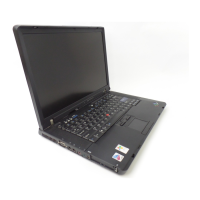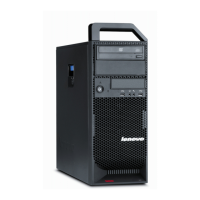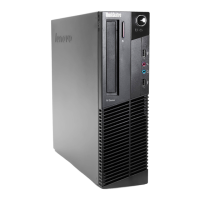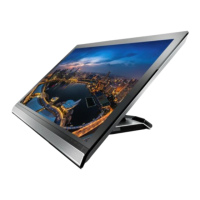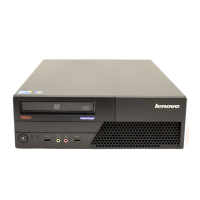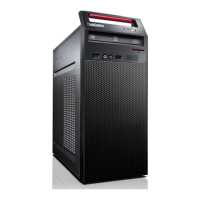Do you have a question about the Lenovo THINKPAD P71 and is the answer not in the manual?
Information on using AC power and battery power for optimal performance and power management.
Information on proper care and maintenance for reliable computer operation.
Managing passwords for computer and data security.
Using fingerprint reader for authentication and enrolling fingerprints.
Instructions for installing a new Windows 10 operating system.
Updating UEFI BIOS and navigating BIOS menus.
Steps to configure RAID using the Intel RST utility.
Procedures for creating and deleting RAID volumes.
Resetting drives and rebuilding RAID 1 volumes.
Tips for problem prevention and using diagnostic tools.
General troubleshooting approach and steps for unresponsiveness.
Handling keyboard spills and resolving common error messages.
Troubleshooting steps for issues related to the computer screen.
Troubleshooting steps for issues with external monitors.
Troubleshooting steps for various audio issues.
Troubleshooting fingerprint reader and battery operational issues.
Troubleshooting power adapter and general power supply issues.
Troubleshooting startup and sleep/hibernation mode problems.
Troubleshooting issues with hard disk and solid-state drives.
Troubleshooting issues related to the computer and docking station connection.
Steps to reset the computer, keeping or removing files, and reinstalling Windows.
How to recover or repair the OS when Windows 10 fails to start.
Steps to create and use a recovery USB drive for troubleshooting and recovery.
Instructions for replacing the removable battery, including safety warnings.
Steps to remove and replace the bottom cover of the computer.
Instructions for replacing the optical drive.
Instructions for replacing the wireless-WAN card.
Instructions for replacing the M.2 solid-state drive.
Instructions for removing and replacing the keyboard.
Sources from Lenovo for help, service, and technical assistance.
Information on using AC power and battery power for optimal performance and power management.
Information on proper care and maintenance for reliable computer operation.
Managing passwords for computer and data security.
Using fingerprint reader for authentication and enrolling fingerprints.
Instructions for installing a new Windows 10 operating system.
Updating UEFI BIOS and navigating BIOS menus.
Steps to configure RAID using the Intel RST utility.
Procedures for creating and deleting RAID volumes.
Resetting drives and rebuilding RAID 1 volumes.
Tips for problem prevention and using diagnostic tools.
General troubleshooting approach and steps for unresponsiveness.
Handling keyboard spills and resolving common error messages.
Troubleshooting steps for issues related to the computer screen.
Troubleshooting steps for issues with external monitors.
Troubleshooting steps for various audio issues.
Troubleshooting fingerprint reader and battery operational issues.
Troubleshooting power adapter and general power supply issues.
Troubleshooting startup and sleep/hibernation mode problems.
Troubleshooting issues with hard disk and solid-state drives.
Troubleshooting issues related to the computer and docking station connection.
Steps to reset the computer, keeping or removing files, and reinstalling Windows.
How to recover or repair the OS when Windows 10 fails to start.
Steps to create and use a recovery USB drive for troubleshooting and recovery.
Instructions for replacing the removable battery, including safety warnings.
Steps to remove and replace the bottom cover of the computer.
Instructions for replacing the optical drive.
Instructions for replacing the wireless-WAN card.
Instructions for replacing the M.2 solid-state drive.
Instructions for removing and replacing the keyboard.
Sources from Lenovo for help, service, and technical assistance.
| Form factor | Clamshell |
|---|---|
| Product type | Mobile workstation |
| Product color | Black |
| Housing material | Aluminium, Glass fibre, Magnesium, Polyphenylene sulfide (PPS) |
| LED backlight | Yes |
| Display surface | Matt |
| Display diagonal | 17.3 \ |
| Display brightness | 300 cd/m² |
| Native aspect ratio | 16:9 |
| Contrast ratio (typical) | 800:1 |
| Bus type | DMI3 |
| Stepping | B0 |
| Tjunction | 100 °C |
| Processor cache | 8 MB |
| Processor cores | 4 |
| System bus rate | 8 GT/s |
| Processor socket | BGA 1440 |
| Processor threads | 8 |
| Processor codename | Kaby Lake |
| Processor frequency | 3 GHz |
| Processor cache type | Smart Cache |
| Configurable TDP-down | 35 W |
| Processor lithography | 14 nm |
| Processor manufacturer | Intel |
| PCI Express slots version | 3.0 |
| Processor boost frequency | 4 GHz |
| Processor operating modes | 64-bit |
| PCI Express configurations | 1x16, 1x8+2x4, 2x8 |
| Thermal Design Power (TDP) | 45 W |
| Maximum number of PCI Express lanes | 16 |
| Memory slots | 4x SO-DIMM |
| Internal memory | 32 GB |
| Memory clock speed | 2400 MHz |
| Memory form factor | SO-DIMM |
| Internal memory type | DDR4-SDRAM |
| Maximum internal memory | 64 GB |
| Memory upgrade note | Additional memory sold separately |
| SSD capacity | 512 GB |
| SSD interface | PCI Express |
| Storage media | SSD |
| SSD form factor | M.2 |
| Total storage capacity | 1024 GB |
| Compatible memory cards | MMC, SD, SDHC, SDXC |
| Number of SSDs installed | 2 |
| On-board graphics card ID | 0x591D |
| Discrete graphics card model | NVIDIA® Quadro® P3000 |
| On-board graphics card model | Intel® HD Graphics P630 |
| Discrete graphics card memory | 6 GB |
| On-board graphics card family | Intel® HD Graphics |
| Maximum on-board graphics card memory | 1.7 GB |
| On-board graphics card OpenGL version | 4.4 |
| On-board graphics card base frequency | 350 MHz |
| On-board graphics card DirectX version | 12.0 |
| On-board graphics card dynamic frequency (max) | 1100 MHz |
| Battery capacity | 96 Wh |
| Battery life (max) | 9.8 h |
| Audio chip | Realtek ALC3268 |
| Speaker power | 2 W |
| AC adapter power | 230 W |
| AC adapter frequency | 50 - 60 Hz |
| AC adapter input voltage | 100 - 240 V |
| Password protection type | HDD, Power on, Supervisor |
| Front camera HD type | HD |
| Front camera resolution | 1280 x 720 pixels |
| Front camera signal format | 720p |
| Front camera resolution (numeric) | 1 MP |
| Antenna type | 2x2 |
| Wi-Fi standards | 802.11a, 802.11b, 802.11g, Wi-Fi 4 (802.11n), Wi-Fi 5 (802.11ac) |
| Bluetooth version | 4.1 |
| Top Wi-Fi standard | Wi-Fi 5 (802.11ac) |
| Ethernet LAN data rates | 10, 100, 1000 Mbit/s |
| HDMI version | 1.4b |
| Charging port type | DC-in jack |
| USB 2.0 ports quantity | 0 |
| USB Sleep-and-Charge ports | 1 |
| Sustainability certificates | RoHS, ENERGY STAR |
| Certification | MIL-STD-810G |
| Pointing device | ThinkPad UltraNav |
| Processor code | SR32K |
| Processor ARK ID | 97463 |
| Processor package size | 42 x 28 mm |
| Supported instruction sets | AVX 2.0, SSE4.1, SSE4.2 |
| Intel Identity Protection Technology version | 1.00 |
| Motherboard chipset | Intel® CM238 |
| Depth | 275.5 mm |
|---|---|
| Width | 416 mm |
| Weight | 3300 g |
| Height (rear) | 34.2 mm |
| Height (front) | 29.9 mm |
